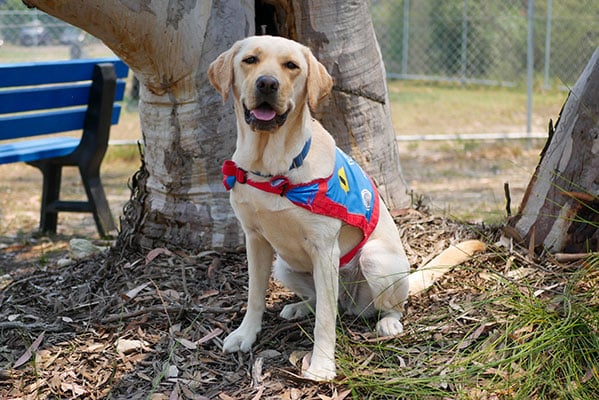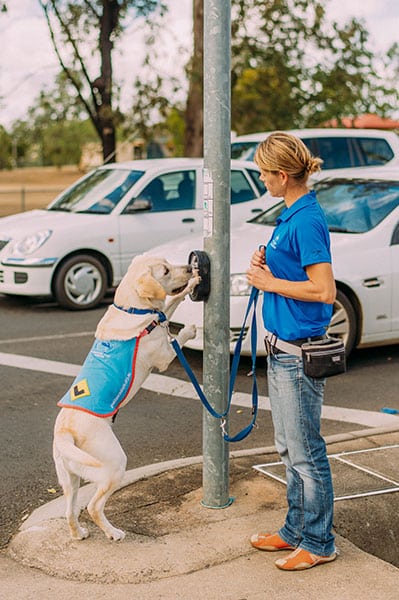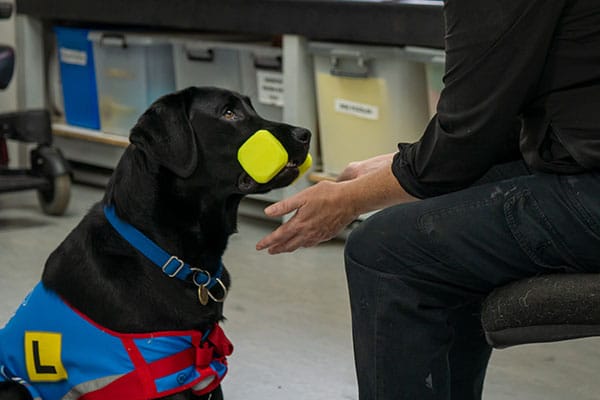Public access for dogs. It sounds simple, but there are so many questions. Does your Assistance Dog get to go everywhere even if a restaurant or hotel says they don’t allow dogs? What if you have a companion animal who you rely on for emotional support? How do you even get a dog certified for public access rights?
Trying to navigate the world of service dogs, public access rights, and where you stand legally can feel complicated. But we’re here to clear up a few commonly-asked questions around public access rights for dogs of all kinds.
First up, can your Assistance Dog go anywhere? Anywhere at all?
Do public access rights for dogs trump other laws?
In a nutshell, yes. Laws around public access for dogs trump other laws. Mostly, anyway.
According to the Disability Discrimination Act, if your Assistance Dog (or AD) is appropriately trained and certified to assist you, and meets hygiene and behaviour standards, access to public spaces and services is guaranteed.
The DDA takes precedence over other laws. This includes both state laws and local council regulations. The one exception is The Civil Aviation Act 1988 (CAA). This Act allows an airline to refuse to let your Assistance Dog on the plane if there is a genuine concern that the size of the dog will be a danger on the flight.
Finally, you should know about two more exceptions. It is legal to discriminate against the person with the disability on the ground of the disability, if:
- the discriminator reasonably suspects that the assistance animal has an infectious disease; AND
- the discrimination is reasonably necessary to protect public health or the health of other animals.
So in the vast majority of cases, your right to bring your AD along trump other rules and laws. However, it doesn’t mean you’ll find it easy to take your dog everywhere.
Firstly, you are legally obliged to provide evidence that your dog is a registered Assistance Dog if asked. If your dog has passed the public access test, they will have an identity card you can use for this purpose. But many people will still argue with you as the regulations around service dogs aren’t always understood.

What dogs have public access rights?
Rights to public access for dogs are limited strictly to Assistance Dogs. Other dogs are not eligible for these same access rights. Why? Assistance Dogs are not pets. They are considered a medical aid. They are specifically trained to assist a person living with disability. Guide dogs, hearing dogs, and service dogs all count as a type of Assistance Dog.
“Assistance Dog” is essentially an umbrella term which covers any dog who is specially trained to alleviate some of the obstacles associated with someone’s disability. As a result, public access rights are granted to these dogs. And them only. These rights allow them to accompany their owners in places and situations where companion dogs are not allowed.
Therapy dogs and support animals all count as pets or companion animals. They may provide therapeutic support and you may even consider them a crucial part of your life. After all, we know that pets have physical benefits as well as mental wellbeing benefits. But in the eyes of the law, companion dogs are not considered a medical necessity.
Training assistance dogs for public access
Of course, Assistance Dogs aren’t simply born ready to go everywhere with their humans. Training one takes time and dedication. As well as understanding from the general public, of course.
Fran Diogo of Assistance Dogs Australia says “one area in which we try to advocate is the public accessibility for Assistance Dogs in Training. Socialisation from an early age is very important for our dogs achieving success in their expected public accessibility outcomes. Essential to this process is providing Assistance Dogs with access to many different community environments that they need to get used to being in whilst remaining calm and focused for their handlers.
The work we have recently done with the NSW Transport Commission involved us collaborating on a campaign that helps educate ride share drivers on Assistance Dogs, including what to expect from a qualified team or pup in training. This educational exercise aimed to reduce service refusal.
In NSW and QLD, Assistance Dogs in Training have the same accessibility rights for public transport, including ride share options like taxis, Ubers. However, a lot of our volunteers (and clients) still get either refused from time to time, or have to invest a lot of effort into explaining why they need to provide our dogs in training with that opportunity.“
Check out this video for a behind the scenes peek at the training process:
Can you get these rights for any dog?
No.
To do the public access test for dogs and thus be granted these rights, you have to meet strict criteria. It’s also not a quick process, and involves plenty of paperwork as well as a well-governed testing process. The right to public access for dogs is policed and controlled, as it should be.
Assistance Dogs Australia relicenses their pups every year by redoing the public access test. So, if you are receiving a dog from them, you won’t have to take additional steps to train your pup or to do the public access test for dogs.
However, not everybody receives their Assistance Dogs this way. In that case, you have to use an approved trainer or training institution. They’ll work with you to train your dog and help certify them by completing the public access test.
You can’t simply get public access rights for any dog by passing the test. Not everybody – or their dog – is eligible to take it. Legally, companion dogs cannot receive the same access as Assistance Dogs.
To be eligible you must:
- Have a disability as defined by the Guide, Hearing and Assistance Dogs Act 2009 (PDF)
- Rely on a guide, hearing or Assistance Dog to reduce your need for support
- Be able to physically control your dog, or identify an alternative handler to support you to control the dog
- Have your dog pass the PAT and be certified by an approved trainer or training institution.

Are there places dogs with public access rights can’t go?
As we mentioned above, the Disability Discrimination Act means your Assistance Dog can accompany you in almost all spaces. Airlines may be exempt from this, however.
There are also one or two situations in which your Assistance Dog may not have public access rights. Mainly, this refers to areas where a sterile environment is strictly required. This includes:
- Specific clinical settings (e.g. many ICU wards or burn treatment centres)
- Surgically sterilised areas (e.g. a hospital operating theatre)
- Industrial food preparation areas
- Quarantined areas
Have an Assistance Dog of your own? Or perhaps a companion animal? Both can make the world of difference to their humans. That’s why Blue Badge Insurance offers a discount of up to 25% on Assistance Dogs insurance and up to 15% off pet insurance for pet dogs and cats.
Get in touch today for a quote. And while you’re at it, read more about our Assistance Dogs Australia partnership here.








